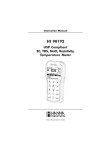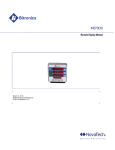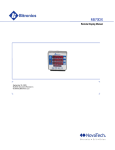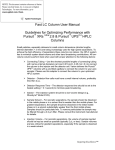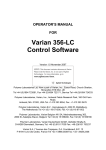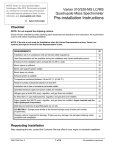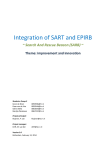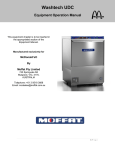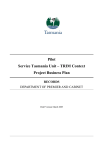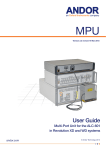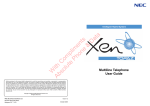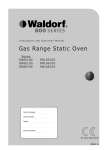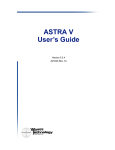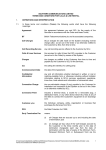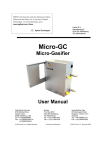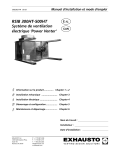Download OPERATOR`S MANUAL - Agilent Technologies
Transcript
OPERATOR’S MANUAL FOR PL-BV 400 RT VISCOMETER NOTICE: This document contains references to Varian. Please note that Varian, Inc. is now part of Agilent Technologies. For more information, go to www.agilent.com/chem. Document 6-27121 Revision 1.05 June 2010 Varian, Inc. offices Varian, Inc. has offices in most countries. The major offices for chromatography products are listed below: Varian, Inc. (Manufacturing site) Essex Road Church Stretton Shropshire SY6 6AX, UK International telephone: +44 1694 723581 International fax: + 44 1694 722171 Varian, Inc. Scientific Instruments 2700 Mitchell Dr Walnut Creek, CA 94598 Telephone: 1 800 926 3000 International telephone: +1.925.939.2400 International fax: +1.925.945.2360 Varian B.V. Postbus 8005 4330 EA Middelburg, The Netherlands International telephone: +31.118.67.1000 International fax: +31.118.62.3193 Varian Australia Pty. Ltd 679 Springvale Rd, Mulgrave, Victoria 3170, Australia International telephone: +61.3.9560.7133 International fax: +61.3.9560.7950 Varian Industria e Comercio Ltda. Avenida Dr. Cardoso de Mello 1644 Sao Paulo 04548-005, Brazil International telephone: +55.11.3238.0400 International fax: +55.11.3238.0410 www.varianinc.com Varian, Inc., is the owner of copyright on this document and any associated software. Under law, the written permission of Varian, Inc. must be obtained before either the documentation or the software is copied, reproduced, translated or converted to electronic or other machine-readable form, in whole, or in part. First published June 2010 in Church Stretton, UK. Comments about this manual should be directed to the MarCom Manager Europe at the factory address above or by e-mail to: [email protected] © 2010 Varian, Inc. Varian and the Varian Logo are trademarks or registered trademarks of Varian, Inc. in the U.S. and other countries. ® All product and company names herein may be the trademarks of their respective owners. All rights reserved. DECLARATION OF CONFORMITY We, Varian, Inc. Essex Road Church Stretton Shropshire SY6 6AX UK declare that the product: ____________________________________________________________________ PL-BV 400 RT Viscometer Part # PL0810-3060 ____________________________________________________________________ conforms with the requirements of EC Directives 89/392, 91/368 & 89/336 by complying with the following Harmonised European Standards: Safety: EN61010 - 1 EMC: EN55022 Conducted emissions: Class B Radiated emissions: Class B* EN50082 ESD (C), Radiated immunity (A), Fast Transient Burst (B), Surge immunity (B), Conducted immunity (A). Dr. S.O’Donohue Head of Instrumentation, Church Stretton 8th June 2010 Document #6/27121 v1.05 i PL-BV 400 RT VISCOMETER WARRANTY (Extract from General Conditions of Sale) Subject as hereinafter stated, if any goods supplied are proved to the reasonable satisfaction of the Seller to be defective in material or workmanship within a period of 12 months from the date of despatch and the Buyer notifies such defect to the Seller in writing within fourteen days of it becoming apparent the Seller shall repair or replace at its option the goods or any part thereof free of charge and any repaired (or replacement) goods will be guaranteed on these terms for the unexpired portion of the 12 month period PROVIDED THAT the Seller shall be under no liability in respect of any defect that has arisen because:of fair wear and tear; or where the goods have not been used, maintained, stored or protected in the proper manner; or the goods have been altered in any way whatsoever or have been subject to unauthorised repair; or the goods have been improperly installed or connected (unless the Seller carried out such installation and connection); or in the case of Instrument Consumables (including wetted parts, lamps etc) they prove defective as aforesaid more than 30 days after delivery notwithstanding the foregoing provisions of this condition; or the Buyer is in breach of any other contract made with the Seller such as the Company's General Conditions of Sale. SAVE AS PROVIDED ABOVE, THE SELLER WILL BE UNDER NO LIABILITY UNDER THE CONTRACT FOR ANY PERSONAL INJURY, DEATH, LOSS OR DAMAGE OF ANY KIND WHATSOEVER WHETHER CONSEQUENTIAL OR OTHERWISE INCLUDING BUT NOT LIMITED TO LOSS OF PROFITS AND THE SELLER HEREBY EXCLUDES ALL CONDITIONS, WARRANTIES AND STIPULATIONS EXPRESS OR IMPLIED, STATUTORY, CUSTOMARY OR OTHERWISE WHICH BUT FOR SUCH EXCLUSION WOULD OR MIGHT SUBSIST IN FAVOUR OF THE BUYER EXCEPT THAT SUCH EXCLUSION WILL NOT APPLY TO ANY IMPLIED CONDITION THAT THE SELLER HAS OR WILL HAVE THE RIGHT TO SELL THE GOODS WHEN THE PROPERTY IS TO PASS OR WHEN THE BUYER DEALS AS A CONSUMER (AS DEFINED IN SECTION 12 OF THE UNFAIR CONTRACT TERMS ACT 1977), ANY IMPLIED TERM RELATING TO THE CONFORMITY OF THE GOODS WITH THEIR DESCRIPTION OR SAMPLE OR AS TO THEIR QUALITY OR FITNESS FOR A PARTICULAR PURPOSE. IN NO CIRCUMSTANCES WILL THE SELLER OR ITS EMPLOYEES, AGENTS, OR SUB-CONTRACTORS BE LIABLE FOR ANY LOSS OR DAMAGE OF ANY KIND WHATSOEVER WHETHER CONSEQUENTIAL OR OTHERWISE CAUSED DIRECTLY OR INDIRECTLY BY ANY NEGLIGENCE OR OTHER TORTIOUS ACT OR BREACH OF STATUTORY DUTY ON THE PART OF THE SELLER OR ON THE PART OF ANY OF ITS EMPLOYEES, AGENTS OR SUB-CONTRACTORS IN CONNECTION WITH OR ARISING OUT OF THE MANUFACTURE OR SUPPLY OF THE GOODS OR IN CONNECTION WITH ANY STATEMENT GIVEN OR MADE (OR ADVICE NOT GIVEN OR MADE) BY OR ON BEHALF OF THE SELLER. Any statement made about the Seller's goods by the Seller or its servants or agents whether orally or in writing is intended for guidance only and the Buyer should not place any reliance thereon without specific enquiry and without ensuring that any matter of concern to him is specifically mentioned in the contract. The Buyer is solely responsible for the suitability of the site for the installation of the goods, for obtaining all and any necessary consents and approvals under planning and building regulations and by-laws and for the preparation of the site, the constitution of foundations and the provision of services so that the site is suitable to receive the goods. Unless expressly provided therein, the contract does not include the installation, erection or commissioning of any goods or equipment or the supervision thereof. Where installation is included in the contract it is the responsibility of the Buyer to advise the Seller of prevailing site conditions, and in particular but without prejudice to the foregoing, physical characteristics, availability of services, normal labour working hours and any local or national labour arrangement or practices which might affect the work, and any other relevant factors. Any additional costs caused by any interruption or delay not attributable to the Seller or to its employees or because the Seller cannot gain access to the site shall be charged to the Buyer together with an appropriate allowance for profit. The Buyer shall also be responsible for providing a safe and healthy working environment for the Seller's employees and the Seller's subcontractors and their employees and shall bear (or reimburse the Seller against) any loss, damage or compensation due to any person in relation to any death or personal injury or destruction or damage to property except to the extent that the same is due to the negligence of the Seller and the Buyer shall except as aforesaid keep the Seller fully indemnified in respect thereof. Document #6/27121 v1.05 ii HEALTH AND SAFETY PL-BV 400 RT Viscometer This detector should be used only in accordance with the instructions stated within this manual. If the detector is used in a manner not specified by the manufacturer, the protection provided may be impaired. Users should observe the following general safety precautions: Ensure that the instructions within this manual are understood and carried out in the operation of the detector. All persons utilizing the detector should have adequate training in its proper set-up, operation, and particularly its safety features. Access covers should not be removed by anyone other than properly trained personnel. No attempt should be made to service the detector without authorization from Varian's service department and contravention of this may result in personal hazard or damage to the detector and will invalidate the manufacturer's warranty. We stress the importance of standard laboratory safe practice (e.g. COSHH regulations) for dealing with electronic laboratory equipment, solvents, etc., in preventing accidents, fires, or potentially hazardous conditions. If in any doubt about the use of the detector contact your local Varian office or local distributor. In the UK and Europe Varian, Inc. Technical Assistance Tel +44 1694 723581 Fax +44 1694 722171 United States Varian, Inc. Technical Assistance & Service Tel, toll free 800 767 3963 Tel (413) 253 9554 Fax (413) 253 2476 Australia Varian Australia Pty. Ltd Sales & Service In Germany Varian Deutschland GmbH Technical Assistance & Service Tel +49 6151 7030 Fax +49 6151 703237 In France Varian SA Technical Assistance & Service Tel +33 1 6986 3838 Fax +33 1 6928 2308 Tel +61 3 9566 1134 Fax +61 3 9566 1471 Service Tel +44 1694 724333 Fax +44 1694 723994 In the Benelux countries Varian B.V. Technical Assistance & Service Tel +31 118 671500 Fax +31 118 671502 Document #6/27121 v1.05 iii SAFETY The following general safety precautions must be observed during all phases of operation, service, and repair of this detector. Failure to comply with these precautions or with specific warnings elsewhere in this manual violates safety standards of design, manufacture, and intended use of the detector. Varian assumes no liability for the customer’s failure to comply with these requirements. Signs and Pictograms Used in this Manual ! WARNING ! ATTENTION ! NOTE WARNING: THE “WARNING SIGN” DENOTES A HAZARD. IT CALLS ATTENTION TO A PROCEDURE OR PRACTICE, WHICH, IF NOT CORRECTLY CARRIED OUT OR ADHERED TO, COULD RESULT IN SEVERE PERSONAL INJURY OR DAMAGE OR DESTRUCTION OF THE INSTRUMENT. PLEASE DO NOT PROCEED BEYOND A WARNING SIGN UNTIL THE INDICATED CONDITIONS ARE FULLY UNDERSTOOD AND MET. ATTENTION: The “ATTENTION sign” denotes relevant information. Read this information first before proceeding, it will be helpful or necessary to complete the task. NOTE: The “NOTE sign” denotes additional information. It provides the user with advice and suggestions to facilitate the operation of the instrument. Document #6/27121 v1.05 iv ! NOTE General Precautions Safety Practices The following general safety precautions must be observed during all phases of operation, service, and repair of this detector. Failure to comply with these precautions or with specific warnings elsewhere in this manual violates safety standards of design, manufacture, and intended use of the detector. Varian assumes no liability for the customer’s failure to comply with these requirements. Perform periodic leak checks on liquid supply lines and connections. Do not allow flammable and/or toxic solvents to accumulate. Follow recommended procedures and protocols for evacuation and disposal of flammable and/or toxic solvents. Never dispose of such products through municipal waste systems ! WARNING Cleaning The individual or group responsible for the use and maintenance of this equipment must carry out appropriate decontamination if hazardous material is spilt on or inside the instrument. Before using any cleaning or decontamination method except those recommended by Varian, users should check with Varian that the proposed method would not damage the equipment. See Appendix for detailed recommended procedures. Document #6/27121 v1.05 v CONTENTS 1. GENERAL INFORMATION 1 1.1 INTRODUCTION ............................................................................................... 1 1.2 SPECIFICATIONS ............................................................................................. 1 1.3 INSTALLATION PROCEDURES............................................................................ 2 1.3.1 Configuring the PL-BV 400 RT Viscometer 2 1.3.2 Connecting the Detector Outputs to the PL DataStream 2 1.3.3 Connecting the PL-BV 400 RT Viscometer Inlet/Outlet 3 2. OVERVIEW OF VISCOMETRY THEORY 5 2.1 THEORY OF ONLINE VISCOSITY MEASUREMENTS ............................................... 5 2.2 UNIVERSAL CALIBRATION ................................................................................ 6 2.3 POLYMER BRANCHING..................................................................................... 6 2.4 FOUR CAPILLARY VISCOMETRY THEORY ........................................................... 7 3. THE GRAPHICAL USER INTERFACE 9 3.1 OVERVIEW ..................................................................................................... 9 3.2 SUMMARY VIEW ............................................................................................ 10 3.3 COMPONENT VIEW ........................................................................................ 11 4. TROUBLESHOOTING 13 4.1 ERRORS....................................................................................................... 13 4.1.1 PL-BV 400 RT Viscometer Errors 14 4.2 GENERAL TROUBLESHOOTING GUIDE ............................................................. 15 APPENDIX 1 - CLEANING & DECONTAMINATION PROCEDURES 16 APPENDIX 2 – PARTS LIST 17 Document #6/27121 v1.05 vi Chapter 1. General Information 1. General Information 1.1 Introduction The PL-BV 400 RT viscometer is based on the proven four-capillary design and is intended for online measurement of viscosity when integrated into the PL-GPC 50 Plus instrument. The combination of refractive index (RI) and viscosity detection provides accurate molecular weight determination for all polymer types based on the universal principle, as well as valuable branching information not otherwise accessible from a concentration detector alone. Due to the four-capillary technology, the differential pressure (DP) signal is very stable to flow rate fluctuations. A continuous monitor of the pressure through the bridge network also provides a consistent reference of the system flow; the inlet pressure (IP). The instrument can be used in both a batch mode, which yields an average intrinsic viscosity, and in true gel permeation chromatography (GPC) mode, which yields a slice-by-slice intrinsic viscosity distribution. From the intrinsic viscosity and known retention volumes or known Mark-Houwink-Sakurada coefficients, the molecular weight as well as distribution of a polymer may be determined. The PL-BV 400 RT Viscometer consists of three components. 1. Precision engineered 4-capillary bridge 2. High sensitivity pressure transducers 3. State of the art low-noise electronics The viscometer is located in the detector compartment section of the PL-GPC 50 Plus with the inlet and outlet of the detector accessed within the column oven compartment. The differential pressure (DP) and inlet pressure (IP) signals are obtained from the rear panel of the PL-GPC 50 Plus, analog output channels 3 (DP) and 4 (IP). 1.2 Specifications PL-BV 400 RT Viscometer Linearity Shear rate (typical) Sensitivity sp Baseline noise (for DP output) Baseline drift (for DP output) Capillary dimensions Recorder output differential pressure Recorder output inlet pressure Cell volume 0.5% FS -1 3000 s -5 1x10 Pa.s <0.25mV <5mV 0.01 in. ID x 24 in. L 1mV/Pa 10mV/Pa 120 µL 1 Document #6/27121 v1.05 PL-BV 400 RT Viscometer Operator’s Manual Chapter 1. General Information 1.3 Installation Procedures 1.3.1 Configuring the PL-BV 400 RT Viscometer The PL-BV 400 RT Viscometer needs to be added to the instrument configuration in order to control it from the PL Instrument Control software. To add the viscometer to the configuration open the PL Instrument Configuration Editor program and select Add Component from either the Configure menu or toolbar icon. From the Add Component dialog select the PL-BV 400 RT component. Once the viscometer component has been added assign the correct Com port. For further information on configuring the system then please see the on-line help within the PL Configuration Editor program and the PL-GPC 50 Plus Operator’s Manual. 1.3.2 Connecting the Detector Outputs to the PL DataStream Using the Detector output cables supplied, attach the BNC connector ends of the cables to the Ports labelled "Analogue Output 3 and 4" on the rear of the PL-GPC 50 Plus and the other ends to the Detector Input Channels (e.g. Channel 2 and 3) on the front of the PL DataStream. The differential pressure (DP) and the inlet pressure (IP) outputs from the PL-BV 400 RT viscometer are connected internally to analogue outputs 3 and 4 respectively. The PL-BV 400 RT Viscometer also has a Specific Viscosity output, which is obtained from analogue output 8. THE SPECIFIC VISCOSITY OUTPUT CANNOT BE USED WITH CIRRUS™ MULTI. 2 Document #6/27121 v1.05 PL-BV 400 RT Viscometer Operator’s Manual Chapter 1. General Information 1.3.3 Connecting the PL-BV 400 RT Viscometer Inlet/Outlet The PL-BV 400 RT Viscometer is connected in parallel to the RI detector. The plumbing connections are all situated within the column oven compartment. The PLBV 400 RT Viscometer and RI detector should be connected as follows. 1. Connect the supplied 30 cm 0.010 in. ID stainless steel tube from the outlet of the column to one of the supplied Valco T-pieces. 2. From the same Valco T-piece connect the supplied 10 cm 0.010 in. ID stainless steel tube to the inlet of the viscometer (bottom connection of the viscometer) and connect the approximately 40 cm 0.010 in. ID stainless steel tube to the inlet of the RI detector (bottom connection for the PL-RI detector and top connection for the Knauer RI detector). The length of tube to the RI inlet will vary so as to obtain a 50:50 flow split between the RI and viscometer. See below for flow split ratio calculations. 3. Connect the two supplied 10 cm 0.040 in. ID PTFE tubes from the outlets of the viscometer and RI to the other Valco T-piece. 4. Connect the PTFE tube labelled with the blue band, the waste tube to the same Valco T-piece. Figure 1.3.3.1 Schematics of the Inlet and Outlet Connections for the PL-BV 400 RT Viscometer and the PL-RI Detector in Parallel Flow Split Ratio Calculations The flow split ratio is the ratio between the recorded inlet pressures (IP) from the viscometer with and without the RI detector connected in the system. Flow Split Ratio IP(RI Visc) IP(Visc Only ) * 100 Therefore if the flow split ratio were 60% then 60% of the flow would be going through the viscometer, i.e. if running the system at 1.0 mL/min then the flow through the viscometer would be 0.6 mL/min. To record the IP for the viscometer only, disconnect the stainless steel tube connecting the RI inlet to the Valco T-piece and connect a column end plug to the Tpiece. Autozero the IP output at zero flow and then set the same flow rate as used 3 Document #6/27121 v1.05 PL-BV 400 RT Viscometer Operator’s Manual Chapter 1. General Information when both detectors are connected. Purge both the IP and DP transducers and allow the system to stabilize. Once the system has stabilized record the IP value. 4 Document #6/27121 v1.05 PL-BV 400 RT Viscometer Operator’s Manual Chapter 2. Overview of Viscometry Theory 2. Overview of Viscometry Theory 2.1 Theory of Online Viscosity Measurements When a polymer dissolves in a liquid, the interaction of the two components stimulates an increase in polymer dimensions over that of the unsolvated state. Due to the vast difference in size between solvent and solute, the frictional properties of the solvent in the mixture are drastically altered, and an increase in viscosity occurs which should reflect the size and shape of the dissolved solute, even in dilute solutions. The dissolved polymer coil disturbs the linear flow of solvent, resulting in a resistance to flow, which is observed as an increase in viscosity. This was first recognized in 1930 by Staudinger, who found an empirical relation between relative magnitude of increase in viscosity and the molar mass of the polymer. The Intrinsic viscosity [] is a measure of the viscosity of a polymer solution, as the concentration tends to zero, i.e. at very low concentrations. It is this parameter, therefore that is a characteristic of isolated polymer chains in solution and can be considered to be proportional to the density of the polymer coil. For a given polymer and solvent system at a specified temperature, [] can be related to molecular weight, M, through the Mark-Houwink-Sakurada equation. [] = KM Where K and are coefficients specific to the polymer, solvent system and temperature. These can be determined by calibrating with polymer standards of known molecular weights. A plot of Log([]) versus Log(M), a Mark-HouwinkSakurada plot, will be a straight line as long as the Universal Calibration is obeyed. 5 Document #6/27121 v1.05 PL-BV 400 RT Viscometer Operator’s Manual Chapter 2. Overview of Viscometry Theory Values of reflect the size of the molecule in solution and for a random coil polymer, range between 0.5 for a polymer dissolved in a theta solvent to about 0.8 in a very good solvent. 2.2 Universal Calibration Benoit (1967) showed that polymers of different structure fall on the same calibration curve if the intrinsic viscosity is included as a calibration parameter. A calibration plot of the product of intrinsic viscosity and molecular weight ([].M) versus elution volume is a "Universal Calibration" as shown below in Figure 2.2.1. This allows the system to be calibrated with polymer standards of one type and then analyze polymers of another type and still obtain accurate molecular weight distributions. Figure 2.2.1 A Universal Calibration Plot Therefore for an unknown polymer sample the Universal Calibration is used to convert the intrinsic viscosity, determined for each slice across the distribution from the viscometer, to molecular weight. 2.3 Polymer Branching The determination of the degree of long chain branching has long occupied polymer chemists. In polymer solutions, the branching factor, g, is the starting point for many branching calculations. 6 Document #6/27121 v1.05 PL-BV 400 RT Viscometer Operator’s Manual Chapter 2. Overview of Viscometry Theory [ ] g b [l ] 1 Where b is the intrinsic viscosity of the branched polymer and l is the intrinsic viscosity of the linear polymer of the same molecular weight. is the “structural model” parameter, which is user defined. 2.4 Four Capillary Viscometry Theory The PL-BV 400 RT Viscometer employs the fluid flow equivalent of the analogous Wheatstone bridge electrical circuit. Solvent travels down a bridge of four capillaries of equal resistance arranged as shown in Figure 2.4.1. Figure 2.4.1 Plumbing Diagram of PL-BV 400 RT Viscometer The differential pressure transducer monitors the pressure drop across the bridge, P, and the inlet pressure transducer measures the pressure drop through the bridge, Pi . When the sample is introduced across capillary 4 (C4) of the bridge, an imbalance is caused due to the holdup columns. This change in pressure, P is proportional to the specific viscosity, sp, according to the following equation. sp 4P Pi 2P Where P is the differential pressure across the bridge and Pi , is the pressure of the flow through the capillary bridge. The instrument makes a true differential measurement directly, making it very sensitive to dilute solution viscosity measurements. The intrinsic viscosity, [] is ideally obtained by measuring the specific viscosity values at several finite concentrations and extrapolate to zero concentration. [ ] lim (sp c) c0 7 Document #6/27121 v1.05 PL-BV 400 RT Viscometer Operator’s Manual Chapter 2. Overview of Viscometry Theory However, the concentrations used in GPC are low enough for the equation to be valid over a typical chromatogram, and thus an extrapolation to the true intrinsic viscosity is not required, since the concentration is close enough to the limiting concentration. All of the data acquisition and data processing are accomplished using Cirrus ™ Multi software, which enables calculation of molecular weight and intrinsic viscosity distributions using algorithms for Universal Calibration. Branching information can also be obtained from Cirrus Multi. 8 Document #6/27121 v1.05 PL-BV 400 RT Viscometer Operator’s Manual Chapter 3. The Graphical User Interface 3. The Graphical User Interface A Windows based Graphical User Interface (GUI) providing total instrument control is used to operate the PL-BV 400 RT Viscometer as well as the other components of the PL-GPC 50 Plus and the PL-AS RT & MT autosamplers. This intuitive interface provides simplistic control as well as a comprehensive monitoring system. The instrument status can be rapidly assessed for each of the instruments modules. For further information on the PL Instrument Control software please see the on-line help within the program. To start the control software select the PL Instrument Control item in the PL Instrument Control program group of the Programs option in the Start menu. 3.1 Overview Component View Summary View The Control screen is effectively divided into two main Views, these are: 1. The Summary View 2. The Component View 9 Document #6/27121 v1.05 PL-BV 400 RT Viscometer Operator’s Manual Chapter 3. The Graphical User Interface 3.2 Summary View The summary view displays all the components of your PL-GPC 50 Plus instrument as a "Tree" providing you with status for each of the modules and a quick way of access to the various components, parameters and options available within the PL Instrument Control software. For the PL-BV 400 RT Viscometer the status information within the Summary View reports the differential and inlet pressure outputs, DP and IP. Clicking on the component names displayed in red in the Summary View of the screen changes the control display shown in the Component View. A green LED next to the viscometer component indicates the detector is being controlled and running whereas a red LED would indicate the detector is either not running or not controlled. For further information on the Summary View please see the on-line help within the PL Instrument Control software. 10 Document #6/27121 v1.05 PL-BV 400 RT Viscometer Operator’s Manual Chapter 3. The Graphical User Interface 3.3 Component View The component view displays the component view of the selected component providing you access to parameters and/or direct commands for that specific component. In general each component view contains a number of common items and options. The actual items available in a view are dependent on the component selected. The component view for the PL-BV 400 RT Viscometer is shown below. Status Bar Parameter Grid On-line Help Button Help Output Window Action List Action Button(s) Status Bar – This displays information about the viscometer component and it's current status. On-line Help Button – This is a direct link to the on-line help for the viscometer component view. Parameter Grid – This displays the current set purge time for both the DP and IP purges. To set and update the purge time enter the required value in the Set Value column and press the Update button, . To undo the new set value prior to pressing the Update button press the Undo button, . To reset the purge time back to the default value press the Factory Reset button, . 11 Document #6/27121 v1.05 PL-BV 400 RT Viscometer Operator’s Manual Chapter 3. The Graphical User Interface Help Output Window – This displays a simple summary help for the purge time parameter and viscometer actions. To view this information, select the parameter or action. The information displayed in the Help Window will be a short description about the action or parameter, the Factory Default Value and the Minimum and Maximum Values for the purge time. Action List – This is a drop down list of the actions that are available for the viscometer. To run an action, select the required one from the Action List and press the Submit Action button, . Action Button(s) – The actions available for the viscometer are displayed as Action Buttons, as well as being found in the Action List. To run an action, press the required Action button. Press the Stop button, viscometer. to stop all the procedures currently running on the For further information on the viscometer component view please see the on-line help within the PL Instrument Control software. For information on the Toolbar menus please see the on-line help within the PL Instrument Control software. 12 Document #6/27121 v1.05 PL-BV 400 RT Viscometer Operator’s Manual Chapter 4. Troubleshooting 4. Troubleshooting 4.1 Errors Any error(s) that occur with communications or operations (running component actions, updating parameters etc.) with the viscometer, the Diagnostic Output Window will automatically open with the error(s) displayed in the Component Error Status Tab of the Diagnostic Output Window as shown below. Each error is uniquely identified with a number that can be referenced back to the control code. Figure 4.1.1 Diagnostic Output Window Note: The information displayed in last two Tabs is primarily for service diagnostics and the Window does not need to be open for normal operation of the instrument. If an error is displayed it needs to be cleared in order for the diagnostic window to be closed, allowing access back to the PL Instrument Control software. To clear an error press the Select button to highlight the row and press the Clear button. Multiple errors can be selected at a time. Once all errors have been cleared the diagnostic window can be closed. Clearing an error will stop all procedures that are running and attempting to communicate with the viscometer. To re-establish communications with the viscometer either select the Reconnect option from the Instrument menu or return to the component view and resend the parameter or repeat the required action. The errors that can be displayed from the software for the viscometer are listed on the following pages. 13 Document #6/27121 v1.05 PL-BV 400 RT Viscometer Operator’s Manual Chapter 4. Troubleshooting 4.1.1 PL-BV 400 RT Viscometer Errors Error Could not initialize specified comms port No response received from the device Cause(s) Action Incorrect Com port assigned to the Ensure the correct Com port has been assigned within the PL component, the PL-GPC 50 Plus is not Instrument Configuration Editor program. Ensure the PL-GPC 50 powered on or the USB cable is not Plus is powered on and the USB cable is connected. connected. Ensure the correct Com port has been assigned within the PL Incorrect Com port assigned to the Instrument Configuration Editor program. Ensure the PL-GPC 50 component or communications lost with the Plus and/or component is powered on. If assigned Com port is component, e.g. power failure. correct and the system is powered on then contact Varian or your local agent. Unrecognized response from the device Turn the PL-GPC 50 Plus off and then on again (ensure the control software has been closed before turning the instrument off). If this error persists then contact Varian or your local agent. The device rejected the last command Incorrect component assigned to the Com Ensure the correct component has been assigned to the correct Com port. port within the PL Instrument Configuration Editor program. Autozero operation could not completely cancel the transducer offset The Viscometer failed to autozero the DP Purge the DP Transducer and ensure it is flushed with solvent. If this signal correctly. error persists then contact Varian or your local agent. The device returned an error Reinitialize the component from the PL Instrument Control software and ensure the initialization is completed successfully. Otherwise The component failed to complete an turn the PL-GPC 50 Plus off and then on again (ensure the control action. software has been closed before turning the instrument off). If unsuccessful and no obvious cause for the error then contact Varian or your local agent. Document #6/27121 v1.05 14 PL-BV 400 RT Viscometer Operator’s Manual Chapter 4. Troubleshooting 4.2 General Troubleshooting Guide DP/IP Baseline Drift Allow sufficient time for system to equilibrate. Ensure the instrument is located in a thermally stable environment. Degas solvent. Purge DP/IP transducers. Ensure laboratory temperature not changing dramatically. DP/IP Baseline Noise Purge DP/IP transducers thoroughly to remove any air bubbles. Purge pump head to remove any air bubbles. Degas solvent. Low Sensitivity Purge DP/IP transducers. Check flow split. Long Retention Times Check pump flow rate. Check for leak on system. 15 Document #6/27121 v1.05 PL-BV 400 RT Viscometer Operator’s Manual Appendix 1 - Cleaning & Decontamination Procedures Appendix 1 - Cleaning & Decontamination Procedures CLEANING AND DECONTAMINATION PROCEDURES ! ARE ONLY TO BE CARRIED OUT BY TRAINED SERVICE PERSONNEL WARNING Cleaning The exterior of the instrument should be cleaned by wiping down with a soft cloth moistened with dilute detergent solution, followed by wiping down with a cloth moistened with deionised water. Do not attempt to clean any of the connectors on the rear panel; water may gain ingress and accessible pins may become bent. Ensure that no moisture enters the instrument. Allow instrument to dry off completely before reinstalling into the PL-GPC 50 Plus and reconnecting power. Decontamination The operator should wear appropriate personal protective equipment for this operation (gloves, safety glasses, lab coat and respirator if level of hazard has been risk-assessed to be sufficiently high). Disconnect the instrument completely and remove it to a fume cupboard if necessary. Open the cover of the instrument to see if any solvent has contaminated the interior. Excess quantities of liquid spilt on or inside the instrument should be mopped up using absorbent cloths, followed by repeated wiping down with soft cloths moistened with Acetone or deionized water (as appropriate to the spilt solvent) until the last traces of the hazardous liquid have been removed. Identify and, if possible, correct the source of the leak. Inspect cabling, parts and surfaces to determine whether any damage has occurred. If in doubt, contact your local Varian Service Dept for assistance. Allow the interior and exterior of the instrument to dry out completely before replacing the cover and reinstalling the PL-BV 400 RT into the PL-GPC 50 Plus. Dispose of contaminated waste appropriately. 16 Document #6/27121 v1.05 PL-BV 400 RT Viscometer Operator’s Manual Appendix 2 – Parts List Appendix 2 – Parts List Part Number Product Description PL0810-3071 PL0810-3087 PL0810-3072 PL0810-3073 PL0810-3074 PL0810-3076 PL0810-3077 PL0810-3078 PL0810-3079 PL0810-3080 PL0810-3081 PL0810-3082 PL0810-3083 PL0810-3084 PL0810-3085 PL0810-3086 PL-BV 400 Bridge Assembly for BV 400HT(PL-GPC 120/220) PL-BV 400 Bridge Assembly for BV 400RT (PL-GPC 50) PL-BV 400 Transducer Assembly (PL-GPC 220) PL-BV 400 Transducer Assembly (PL-GPC 120) PL-BV 400 Electronics Control Module PL-BV 400 Delay Columns (x2) PL-BV 400 Pulse Dampener PL-BV 400 IP Transducer PL-BV 400 DP Transducer PL-BV 400 IP Purge Valve PL-BV 400 DP Purge Valve PL-BV 400 Transducer to Bulk Head Cable PL-BV 400 Control Cable PL-BV 400 Display PCB PL-BV 400 Main PCB PL-BV 400 PSU 17 Document #6/27121 v1.05 PL-BV 400 RT Viscometer Operator’s Manual



























